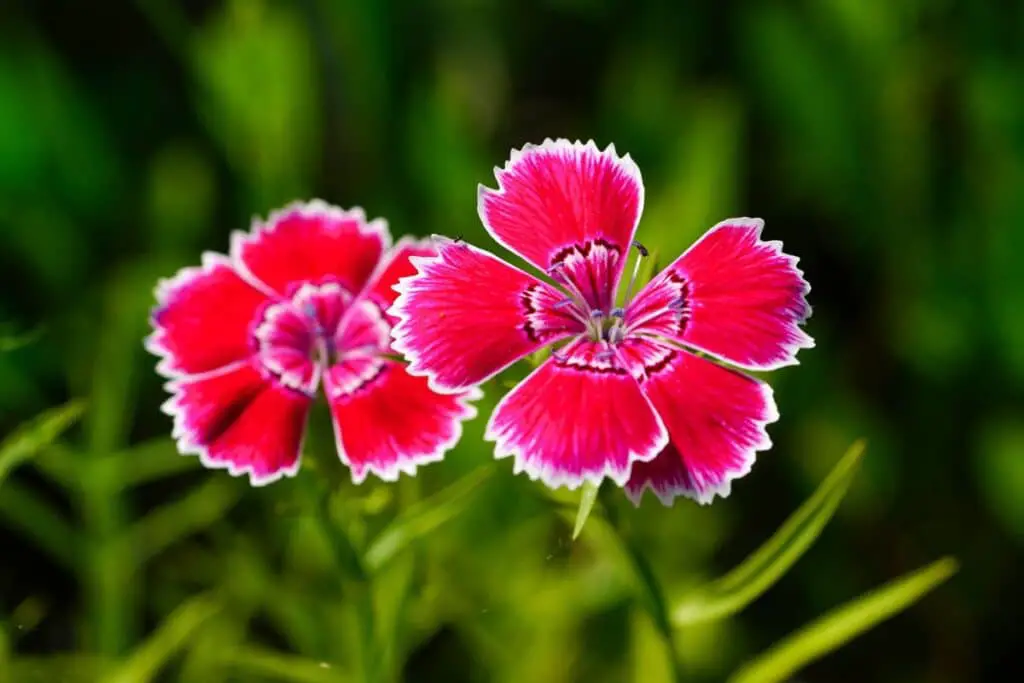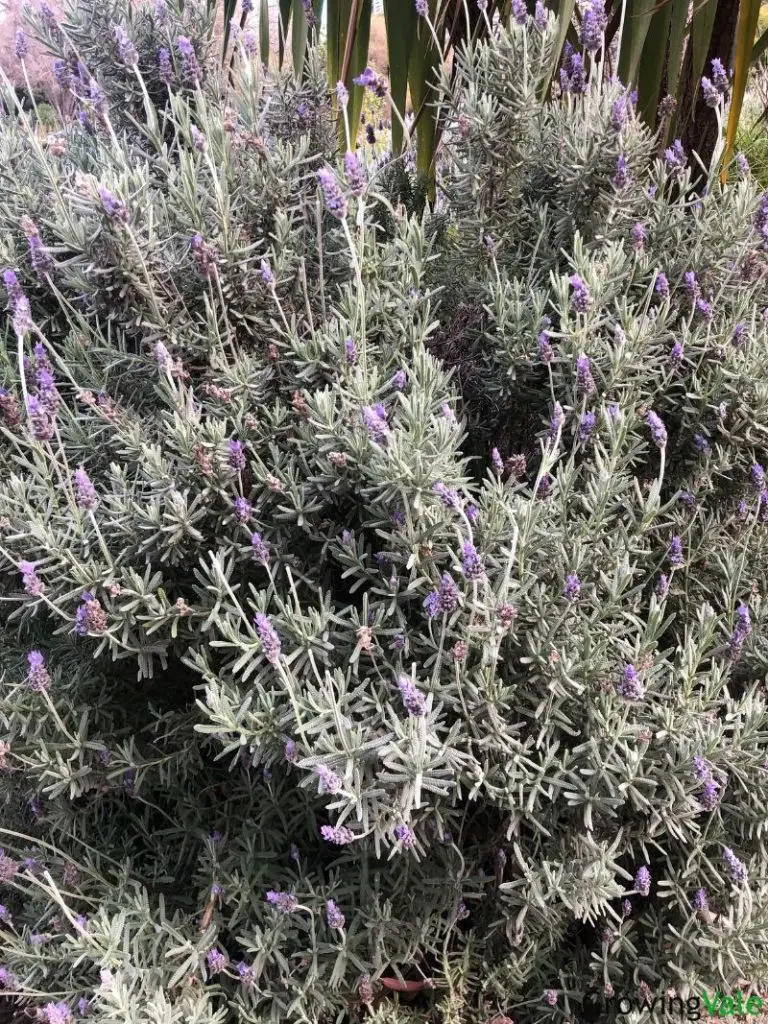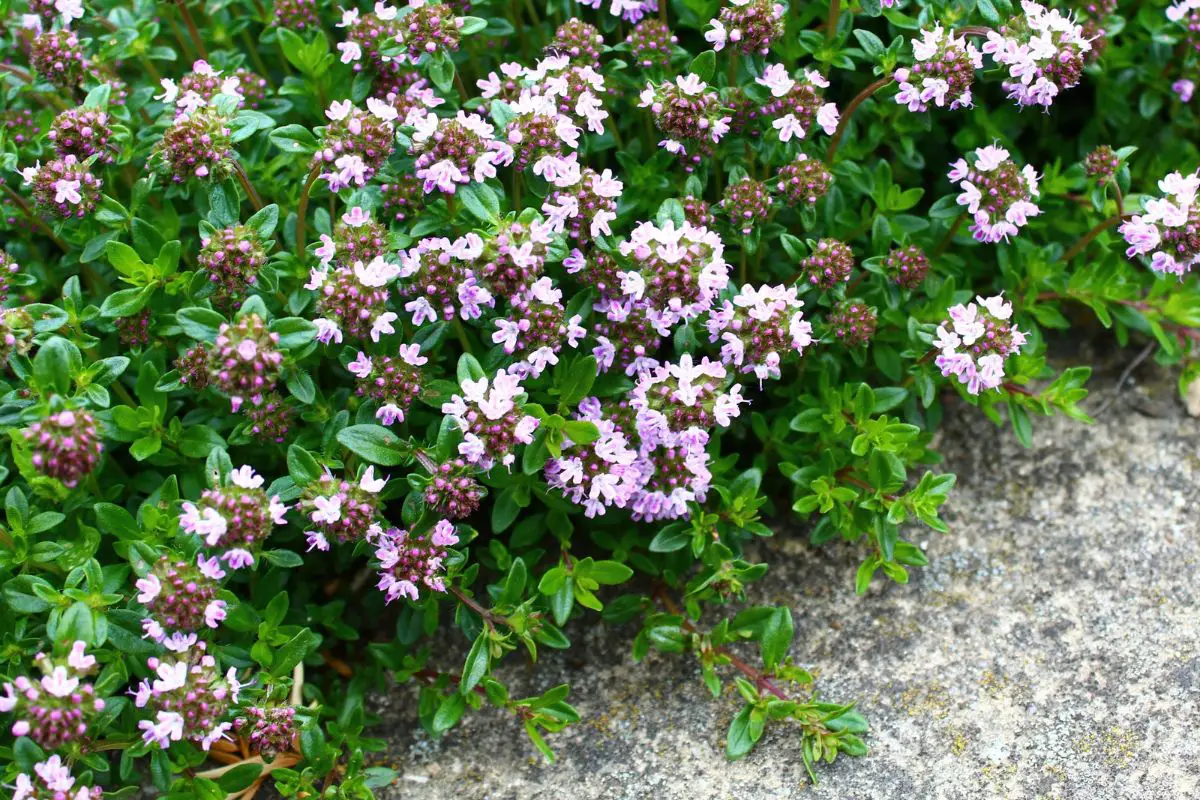Garden thyme (Thymus vulgaris) is a perennial with small foliage and aromatic leaves.
Thyme companion planting is relatively straightforward because of this herb’s tolerance for a wide range of ambient and soil conditions.
Hardy and low-maintenance, thyme forms a strong taproot that can anchor fully grown stems in sloping and rocky areas of the garden. Its healthy mats produce dense, fragrant sprays of pink, purple, lilac, or white blooms in summer.
The best thyme companion plants are other herbs that favor well drained soil, full sun to partial shade conditions, and tolerance for dry conditions. Thus, drought tolerant perennials like sedums, rosemary, and lavender are generally the preferred options of experienced horticulturists working with creeping thyme.
Planting Thyme with Vegetables and Other Perennials
Creeping thyme can be used as a companion plant for aesthetic or functional purposes. Some landscapers use this low-maintenance herb to smother weeds or to fill in the gaps between larger garden plants and shrubs.
Others may use its fragrance to repel vegetable pests like cabbage worms, cabbage moths, cabbage loopers, tomato hornworms, and potato beetles.
Many detrimental garden pests are deterred by both the scent and taste of creeping thyme leaves and stems because of their potent essential oil.
Moreover, this herb’s flowers attract beneficial insects and honey bees. Therefore, thyme enhances the biodiversity profile of gardens while preventing pest infestations.
Plants That Grow Well with Creeping Thyme
Dianthus Hybrids (Dianthus spp.)

Dianthus, which comes in hundreds of species and dozens of dazzling cultivars, is often used in companion planting due to its compact nature. Planting thyme next to a few stands of mature dianthus can help fill out the gaps and draw attention to their colorful and fragrant flowers.
Dianthus blooms come in a wide range of colors, with many hybrids producing petals that have at least 2 or 3 colors. Undeniably eye-catching, they attract honeybees and tons of other pollinators to garden beds. Able to tolerate brief periods of drought, this perennial plant favors well-draining soil.
Tickseed (Coreopsis spp.)

Coreopsis species, also known as tickseed and calliopsis, are remarkably low-maintenance companion plants for thyme. Growing thyme next to their established clumps should bring out the colors of their vivid and spritely blooms. Similar in shape and form to daisies, the yellow blooms appear through summer.
Coreopsis is native to North America, where its flowers attract honey bees, garden moths, and parasitic wasps.
Aim to grow thyme around the base of their shoots to reduce rates of weed growth and self-seeding. Other drought tolerant perennials should also easily proliferate around coreopsis stems.
Sedums (Sedum spp.)
Must-haves in succulent and cacti gardens, sedums are great companion plants for perennials that favor dry, well draining substrates. They come in many growth forms and sizes, with leaves that are able to store large amounts of water. Usually plump and smooth in appearance and texture, sedums favor sandy soil.
House Leeks (Sempervivum spp.)
Like sedums, sempervivums or house leeks prefer dry conditions. Their roots should be situated in substrates that are allowed to dry out completely before being exposed to more moisture.
Due to their petite form and their capacity to send out offsets, they are chiefly grown as ground cover companion plants next to larger succulents.
Both house leeks and thyme can be grown next to each other to create a lush garden with an alpine feel. Note that these companion plants can tolerate moist soil through warm summers, but they are likely to die back when exposed to waterlogged conditions.
Rosemary (Salvia rosmarinus)
Many garden plants benefit from being planted close to rosemary, which is truly one of the best companion plants due to its pest-repellent essential oil.
Creeping thyme should blend seamlessly along the base of larger rosemary bushes, which can add just the right amount of texture and vertical dimension to herb gardens.
Chives (Allium schoenoprasum)
Chives also possess oils that can be used as a natural pest repellent. It is a great companion plant for low-growing vegetables and herbs outdoors. Occasionally, it is also grown as an indoor plant in regions where its foliage is frequently used as a garnish.
Lavender (Lavanda spp.)

Thyme thrives next to various types of lavender, which are generally good companion plants for perennials that favor dry conditions. Both lavender and thyme are perfect for creating a woodland garden that will naturally repel pests.
The aromatic qualities of both creeping thyme and lavender can turn away many troublesome insects and grazers.
Sweet Alyssum (Lobularia maritima)
Versatile, eye-catching, and low-maintenance, alyssum is one of the most ideal companion plants for lemon thyme because it can also be used to fill out gaps in well-draining gardens. Like creeping thyme, it tends to grow as a ground cover plant.
Sweet alyssum can quickly send out self-propagating stems with small, grayish-green foliage and tiny bouquets of white, purple, or pink flowers. The delightful scent of the blooms attracts pollinators that frequent thyme plants.
Bellflowers (Campanula spp.)
As far as thyme companion planting go, bellflowers are a smart choice because they are tolerant of drought conditions and favor well-draining soil.
Their upright stems complement the appearance of thyme planted around or close to their base. Their showy, purple flowers are perfect for adding complexity to summer borders.
Vegetables and Fruits That Can Be Grown Next to Creeping Thyme
Cabbage
Planting thymes around a cabbage farm is a wise way to keep various pests away from growing leaf heads. Thyme acts as a natural repellent against cabbage worms, cabbage moths, and many other troublesome pests.
Potato
Companion planting with thyme can help keep Colorado potato beetles, flea beetles, and more away from patches of root crops. Growing thyme right next to potatoes should also help prevent weeds from taking hold and competing with crops for nutrients, moisture, and space.
Eggplant
Vegetable companion plants with an erect or vine-like growth habit are a great way to add diversity to the farm or garden. Grow thyme next to stands of eggplant to improve their overall health and yield.
Keep in mind, however, that some types of eggplant may require that you keep the soil moist, whereas creeping thyme might prefer drier substrates.
Strawberries
Creeping thyme can also be cultivated as a companion plant for low-growing fruits. Thyme helps deter pests that tend to travel along the substrate, preventing them from reaching susceptible and tender fruits like strawberries.
Tomatoes
Aromatic herbs are some of the best natural pest repellents for tomatoes. The tomato hornworm, which is known for its bright green appearance, white stripes, and its horn-like tail, dislikes the scent of creeping thyme.
Sweet Corn
Although it is one of the more unlikely companion plants for thyme, sweet corn can benefit from being surrounded by aromatic herbs. Thyme plants, which give off a distinct scent whenever their leaves and shoots are damaged, can repel corn earworms.
Brussels Sprouts
Though brussels sprouts don’t quickly come to mind as one of the most ideal thyme companion plants, some horticulturists grow the two close to one another as a means of repelling pests and grazers.
The strong fragrance of creeping thyme can aid in attracting beneficial insects that might feed on brussels sprouts pests.
Creeping Thyme vs Other Popular Thymes

Creeping thyme, scientifically referred to as Thymus serpyllum, is also known as elfin thyme and Breckland wild thyme. This herbaceous member of the mint family typically grows as a low subshrub. Capable of self-propagating via a network of trailing stems, it is often cultivated as a ground cover plant.
Lemon thyme, caraway thyme, woolly thyme, and more all belong to the same mint family (Lamiaceae) as creeping thyme. While all of these can be used as thyme companion plants, they may have slightly different requirements depending on their growth habits and preferences in the wild.
As a companion plant, thyme works to draw attention to the foliage of other plants. The ideal thyme species to use in companion planting should not compete with nearby plants for resources. Your choice of thyme should be based on the climate and soil conditions of your garden as well as the chief plants you wish to cultivate.
Plants That Should Not Be Planted Next to Creeping Thyme
If you’ve planted thyme next to other herbs with heavy water needs, you’ll notice that one or the other may die back. Note that creeping thyme prefers well-draining soil and will likely suffer when it is grown in wet conditions. Thus, plants like ferns, hydrangeas, and marsh marigolds should not be planted next to this species.
Additionally, plants that favor heavy shade and have the tendency to spread aggressively can overtake creeping thyme. Avoid cultivating thyme in shaded areas and in between plants like vinca, ivy, hosta, epimedium, and hellebores.
*image by YAY_Images&wirestock_creators/depositphotos

